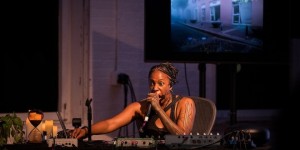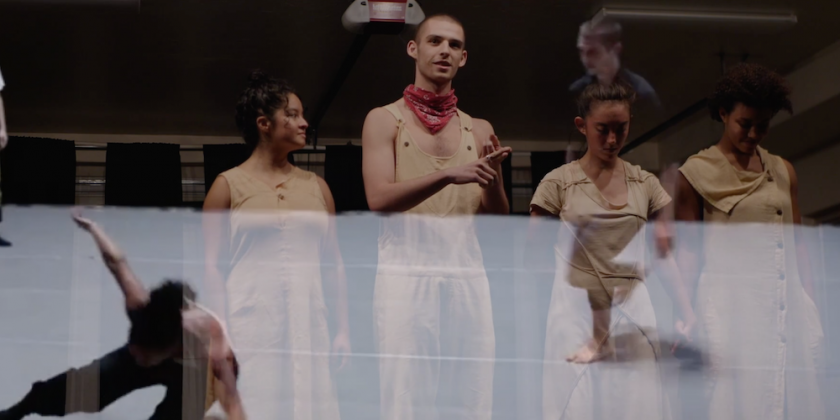Impressions of DD Dorvillier/human future dance corps' "Extra Shapes"

As part of “From Minimalism into Algorithm” at The Kitchen
Movement: Katerina Andreou, DD Dorvillier, Walter Dundervill
Light: Thomas Dunn
Sound: Sébastien Roux
Perhaps this is one of the indisputable facts of life: The human body can only occupy one point in space and time. Where we are and when we are there affects what we see, hear, feel, and think. This physical fixedness limits our choice and defines events. Anyone who’s had a bad seat at a great show can attest to this.
DD Dorvillier/human future dance corps try to work around this in Extra Shapes at The Kitchen. She and two dancers (Katerina Andreou and Walter Dundervill) execute a seventeen-minute sequence three times as concurrent but independent music and lighting compositions unfold. The audience, who is stationed around the perimeter in a single row of chairs, moves to a new seat each time. The artists seem to be enacting an experiment: By switching location, do you experience these seventeen minutes differently? Or do you relive the same seventeen minutes over and over?
The answer to both questions is sort of.
The floor has been divvied up into strips of brown, white, and pink, which evoke a generous slab of Neapolitan ice cream. Each “flavor” features a different element: movement (chocolate), light (vanilla), and sound (strawberry).
The content on all segments leans to the cryptic and the minimal. Over on chocolate, the trio lunges, skitters, and gazes warily, pointedly at one another. They perch nerdy glasses atop their noses and creep back and forth like graceful zombies. The tempo quickens as the sidling segues into skipping. Then the ending: The three, in a wide second position, crumple to the floor. During these ritualistic drills, speakers on the strawberry section emit a spare electronic score by Sébastien Roux while vanilla glows with a palette of ever-changing colors designed by Thomas Dunn: scarlet, icy blue, nesting squares of gold.
Rinse, repeat. Rinse, repeat.
Changing seats does provide a fresh perspective. The second time, I choose a chair near the speakers. The soundtrack, which before registered as an indiscriminate series of noisy beeps and raspy ribbits, reveals carefully constructed layers of orchestration and dynamics. My best seat is smack-dab in front of the strawberry slice in which the strata of sound, light, and movement melt into profundity.
Watching the same piece three times should offer opportunities to go deeper into the material. But there isn’t much to go into: the movement is repetitive, the score sparse. The bold swathes of light are intriguing, but even they become anticipated, noted, and then ignored — been there, seen that. As a result, the effect of Extra Shapes sedates rather than energizes.
Some of this feels due to the performative constraints of space and time. The Kitchen is an intimate environment; moving a dozen or so steps around the perimeter just doesn’t offer the magnitude needed to reframe the work. And with only a few minutes separating each iteration, the piece doesn’t ebb enough to flow again. It feels that where and when keep the what from conspiring into something consequential.
Share Your Audience Review. Your Words Are Valuable to Dance.
Are you going to see this show, or have you seen it? Share "your" review here on The Dance Enthusiast. Your words are valuable. They help artists, educate audiences, and support the dance field in general. There is no need to be a professional critic. Just click through to our Audience Review Section and you will have the option to write free-form, or answer our helpful Enthusiast Review Questionnaire, or if you feel creative, even write a haiku review. So join the conversation.












